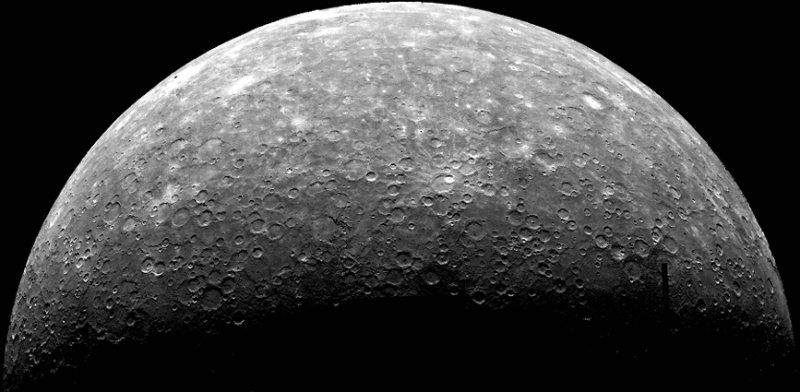I tricked you - or tried to. Yesterday's April 1st LPOD wasn't really of unidentified craters on the Moon, but was of the planet Mercury, taken by the Mariner 10 spacecraft during flybys in 1974/75. The craters do look very similar to lunar craters because the hypervelocity impact process that forms craters is remarkably similar throughout the solar system. Impact craters are so much alike that differences can provide clues about physical or historical differences between planets. One important physical difference between Mercury and the Moon is that Mercury's gravity is more than twice as strong (370 cm/sec2 vs 162 cm/sec2). The greater gravity reduces the flight distance of ejecta from impacts, leading to secondary craters and associated rays being closer to the crater rim. Higher impact velocities for Mercury lead to craters being deeper than on the Moon. An important historical difference between the Moon and Mercury affects the differences in the concentration of craters. In the lunar highlands and on the farside, craters have been accumulating for about 4.4 billion years - there are few empty spaces. On Mercury, spaces between craters led to the suggestion that lava flows were erupted through out the early stages of Mercury's history, erasing earlier craters. There are many other interesting things to say about Mercury, but even more is coming. Mercury Messenger is a spacecraft to be launched to Mercury this summer. People with great patience can marvel at its discoveries on its arrival in 2011! Finally, most people, even astronomers, have never seen Mercury with their own eyeballs. Tonight you can observe Mercury low in the west after sunset.
Technical Details:
The left side image in yesterday's LPOD shows the southern tip of the Michelangelo Quadrangle of
Mercury. The rays come from a bright, apparently unnamed crater in the Bach Quadrangle. The right
side image shows the 130 km wide Sotatsu crater in the Discovery Quadrangle. Both images - and
today's incoming mosaic are from Mark's
site.
Related Links:
MERCURY Mariner 10 Image Project
NASA Atlas of mercury
High Res Mercury Images from Earth
|
Январь Февраль Март Апрель Май Июнь Июль Август Сентябрь Октябрь Ноябрь Декабрь |
|
Публикации с ключевыми словами:
Moon - Луна - Lunar Photo of the Day - LPOD
Публикации со словами: Moon - Луна - Lunar Photo of the Day - LPOD | |
См. также:
Все публикации на ту же тему >> | |
